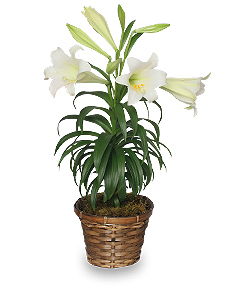 The Easter Lily (Lilium longiflorum) is a midseason bloomer with pure white trumpet-shaped blossoms that are widely grown for pot production or cut flowers. The popularity of the Easter Lily soars during the early spring when Easter is celebrated. However, the natural blooming period for this beloved flower is from early to mid-summer, typically during the months of June and July. Potted Easter Lilies can be grown indoors until temperatures are warmer, when they can be plant outside.
The Easter Lily (Lilium longiflorum) is a midseason bloomer with pure white trumpet-shaped blossoms that are widely grown for pot production or cut flowers. The popularity of the Easter Lily soars during the early spring when Easter is celebrated. However, the natural blooming period for this beloved flower is from early to mid-summer, typically during the months of June and July. Potted Easter Lilies can be grown indoors until temperatures are warmer, when they can be plant outside.
Easter Lily (Lilium longiflorum) Plant Care Tips:
Light Requirements
Potted Easter Lilies grown indoors will need bright, indirect natural daylight; direct, bright sunlight can cause burning issues. Potted Easter lilies (Lilium longiflorum) can be planted in the garden after all danger of frost; this should be done after the flowers have withered away. Plant Easter Lilies in a sunny location; make sure the bed is well drained, organically rich and mulched. Easter lilies like to have their roots shaded; mulch will help shade the roots.
Water Requirements
Potted Easter Lilies (Lilium longiflorum) often arrive with a decorative foil wrapper, paper, plastic or mesh sleeves. Remove the wrapper as soon as possible. The packaging around an Easter Lily can cause the lily to become water logged. Indoors the potted Easter Lilies require a medium moisture level and must not be allowed to stand in water for any length of time. Once the Easter Lily is planted in the garden it should be watered freely during the active growth period and kept towards the moist side during the winter.
Fertilizer Requirements
Although Easter Lilies (Lilium longiflorum) are among the more alkaline tolerant lilies, they are best in slightly acidic to neutral soil (6.5 to 7.0). Potted Easter Lilies that are blooming will not need to be fertilized. Easter Lilies in the garden will need a balanced fertilizer as the new shoots emerge in the spring. During the growing season the Easter Lilies do best with a slow release fertilizer applied once or twice.
Pests and Diseases
Easter Lilies (Lilium longiflorum) are susceptible to a small number of insects, viruses, fungal diseases, and some small animals. Common insects are red lily beetles, slugs, snails and aphids. Insects like aphids can spread viruses, however, many of the new lily varieties are tolerant or immune to these viruses. Gray mold is the most common fungal disease and is most problematic during a wet, cool spring or summer. Root rot is another issue that plagues Easter Lilies that are not in well drain soil or pots with drainage holes. Birds may peck holes in the buds while rabbits, groundhogs, and deer may eat the entire plant.
Temperature
Potted Easter Lilies prefer a cool temperature around 65degrees Fahrenheit during the day and slightly cooler at night. Exposure to wide temperature changes is detrimental to the Easter Lily. They do not like drafts from doors or exposure to excessive heat or dry air; keep away from air ducts. In the garden Easter Lilies can live in Zones 7 to 9. Temperatures in these zone range from a maximum cold of 0 degrees Fahrenheit to multiple days over 86 degrees Fahrenheit.
Propagation and Potting
Easter lily (Lilium longiflorum) seeds should be sown in a cold container as soon as ripe. Easter lilies seeds may also be germinated under lights indoors at 65-70 degrees Fahrenheit during the spring. For vegetative propagation remove scales, offsets, or bulblets as the foliage dies down in the summer. These can be stored for later planting or immediately planted in new areas.


 Find Your
Find Your 
